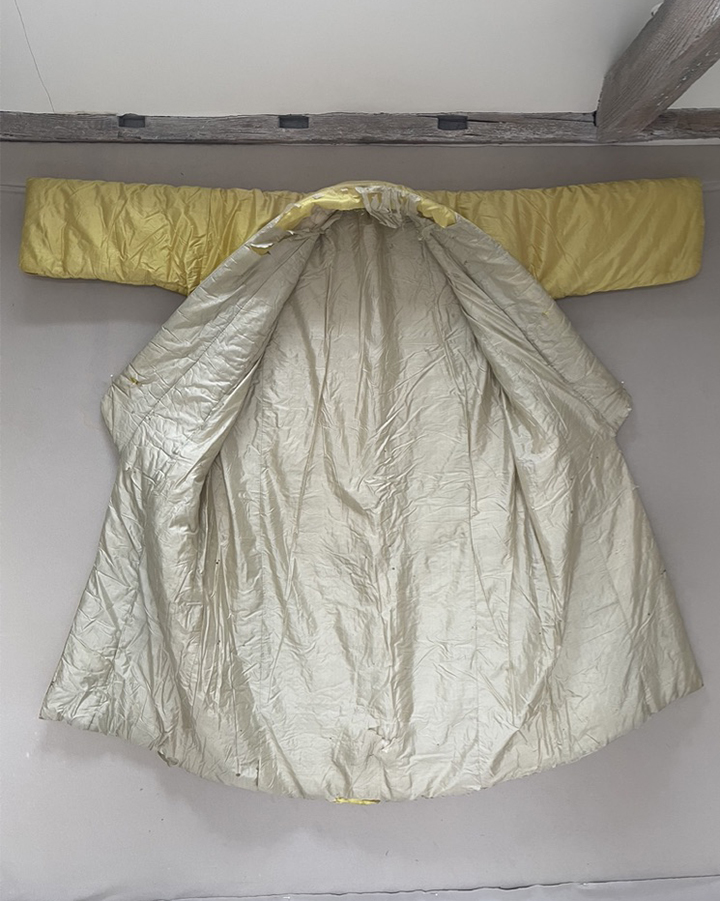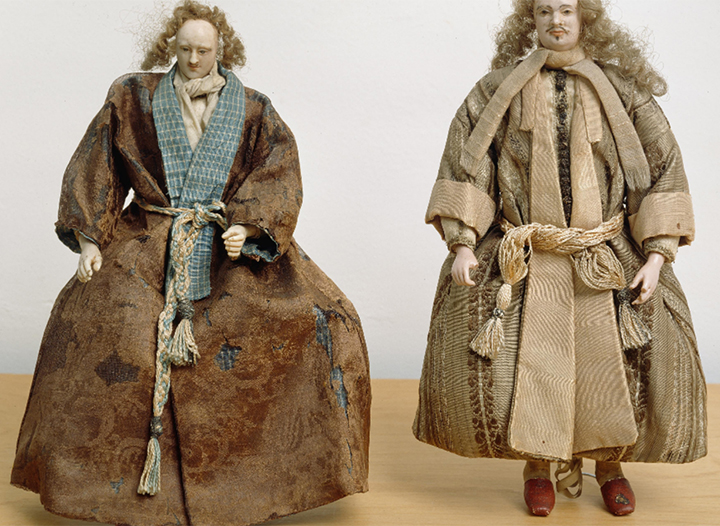


An intriguing gentleman's Japanese style Morning Gown also called Banyan (Gujerati term for merchant *), India gown, night gown, dressing gown, dressing robe and in The Netherlands Japonse rok.
From the Newhouse, Redlynch estate, Salisbury and probably worn by Sir Robert Eyre (1666-1735) or his wife.
The Morning gown was generally floor length, loose cut and comfortable, worn over a shirt, breeches, and waistcoat, often with the waistcoat made of matching fabric. The cut was loose with full sleeves. We think of morning gowns worn in the house, but they were considered formal enough wear to have your portrait painted. Worn at weddings, in gambling houses and casually indoors and outdoors, often with turban. Made from a variety of fabrics, depending on the wealth and status of the owner, brocades, silks, worsteds and Indian chintz are recorded. Fabrics from Japan, India, China and Europe were used.
The design of morning gowns varied slightly but the Japanese style of our gown with long robings was typical of those made in The Netherlands. If you look at Dutch portraits of the period you will see numerous gentlemen wearing similar. In Britain, they tended to be made without the robings and only one other of this style is known, at Newhailes, Musselburgh in East Lothian, Scotland, which was owned by the Dalrymple family, but now National Trust of Scotland**.
I have been very fortunate in receiving information from specialists at the V & A to whom I would like to give my thanks. Anna Jackson, Keeper of the Asia Department told me that the silk was not Japanese, but that the silk wadding definately was. This was highly prized in the 17th and 18th centuries, being both light and warm. It was exported to Europe in large quantities, for Europeans, particularly the Dutch, to make thier own version of Morning Robes or Banyans.**** Avalon Fotheringham, Curator in the Asia Department gave me the following information. The yellow silk taffeta or armoisin (armosin) is probably from Bengal, India. Both terms refer to a thin, plain-weave silk. The fine silk was also a popular choice for linings. Avalon told me there were often complaints about the "dingy" silk lining. The lining on this gown could be described as such. India did not have set loom widths (the gown silk widths are 22 in; 56 cm. The taffeta or armoisin (taffeta) was ordered in colours including lemon yellow, which is how I would describe our gowns colour. 47-66% of all piece good ordered by the EIC in the first half of the 18th century came from Bengal, and armosins formed a staple of Dutch silk exports from Bengal. Also thanks to Susan North, Curator of Fashion in at the V & A for shared information. In North's paper she states that Dutch tailors also began to make Japonse rok and by 1663 there were specialist makers in Amsterdam and Rotterdam. * My thanks also to Jenny Tiramani who gave help on dating the gown.
The fabrics for our gown were exported to The Netherlands, where it was made into a banyan. The outer and lining silk exported from India, probably Bengal and the silk wadding from Japan. It was then either gifted to an ancestor of the house where I bought the gown, or one of the inhabitants bought it in the Netherlands.
Interestingly the morning gown in the Rijks museum, Amsterdam, whose outer fabric is Japanese, has a lemon yellow lining similar to ours, also slighly patchy with whitish markings (dye).
Family History
From the collection of the late Mrs June Jeffreys (1928 – 2016) who married George William Eyre Jeffreys (1931 - 2019) in 1960. The house Newhouse, Redlynch, near Salisbury, Wiltshire, has been in the family for 400 years, the collection inherited through Mr Jeffrey’s family.
In 1633 Giles Eyre of Brickworth House, Whiteparish acquired Newhouse where his descendents have remained until recently. Giles, a reputed Roundhead gave Newhouse to his second son, Ambrose who sold Newhouse to his cousin, judge Sir Samuel Eyre (1633 or 38 - 98). Sir Robert Eyre (1666-1735), Sir Samuel's son inherited the house. He eventually became Chief Justice of the Common Pleas and then Lord Chief Baron of the Exchequer. It would appear from his dates and prestige that he may well have been the owner of the gown. Perhaps it was given to him as a present, or he purchased it on a visit to The Netherlands.
Sir Samuel's daughter Harriet Eyre married George Matcham in 1817, the nephew of Admiral Lord Nelson. The marriage brought about the name change of the family to that of Eyre-Matcham.
There are many interesting ancestors in this family, some assoicated with the Honourable East India Company. John Peirce (1608 - 1676) who captained ships carrying dissenting pilgrims to the New World - America. In 1620 the Virginia Company granted a patent allowing the pilgrims to start a new settlement in the new territory of Virginia****.The Pilgrim Hall Patent of 1621 is named after John Peirce. Later Peirce captained The Golden Fleece, an East India Company ship which he captained from 1671-6. In 1672 on one of his voyages to Surat he plundered a Dutch ship. On June 7 1676, the Bombay ship brought news that Captain Peirce of the Fleece, and two other Company commanders had died from the illness that was sweeping the country. The Fleece, possibly delayed in India by monsoon, returned with “diamonds, musk, ambergris,****** and other fine goods,” as well as Surat calicoes.*****
John Peirce's great great grand daughter, Elizabeth Peirce Bidwell (1729 - 1803) was the youngest daughter of Hugh Bidwell (1700- 17.. ) a senior merchant of the EIC in Bombay. Her mother was Hannah Peirce. Elizabeth married Simon Matcham (1711 - 1776) in 1751. He was a Superintendent of the Bombay Marine of the Honourable East India Company*, a precursor to the Indian navy, and a senior member of the Council of Bombay. Was she really eighteen years older than her husband! Simon died in India in 1776 leaving his family very comfortably off. His widow, Elizabeth returned to England the following year, after her husband’s death, with her son George (1753-1833), who in 1771 became the Resident at Baroche in Gujarat, India for the EIC. George married Catherine (Kitty) Ann Nelson (1767-1831), the sister of Horatio Nelson, later Admiral Lord Nelson.
The Trade
Japan severely restricted foreign trade during most of the Edo period (1603 -1867). Since 1639, the Dutch were permitted to trade with Japan by way of its government-licensed Dutch East India Company. The Dutch were permitted to maintain a trading base on Dejima, a small artificial island in Nagasaki harbour.
Japanese kimono were brought back from Japan for gentleman to wear as informal robes. During the 17th century demand could not be met so Amsterdam and Rotterdam merchants began copying them using Japanese, Chinese and Bengali silks and cottons, painted and printed from South and Southeast Asia.* During the 17th Century Japanese kimonos entered Holland to be worn by gentleman, but later were replaced by Morning Robes or Banyans from India, often of hand painted chintz. All Eastern items arriving in Holland would be auctioned in Amsterdam. To satisfy demand merchants in Amsterdam and Rotterdam began making morning gowns. Silk imports were banned in 1690 so our robe must have been made slightly before then.
Japanese and Chinese dress was made with the fabric being taken from front hem to back hem with no shoulder seams. Our gown has shoulder seams. Anna Jackson told me the Japanese would not have used top stitching round the sleeve edges, nor finished the inner sleeve in a similar way. If made in Japan the seam at the back would have been centred, wheras ours is to one side. The stitching on our gown, although minute, was not quite fine enough to be worked in Japan.
The plain lemon yellow fine silk taffeta or armoisin probably from Bengal, of typical T shape but with kimono type front revers, pointed back collar, seams to the shoulders, the back with two vertical seams, the silk wrapping round to the front, lined in fine Indian ivory armoisin silk taffeta and with Japanese silk wadding.
Silk width 22 in; 56 cm. Lining 22 in; 56 cm.
Length from shoulder top to hem 57 in; 1.45 m.
The sleeves are 16 1/2 in; 42 cm from seam to cuff. Depth 10in; 15 cm.
The front fold back revers are 4 1/4 in; 11 cm wide.
The yellow silk is in very good condition, although patchy in places where the dye has faded. The fine ivory silk lining has small insect holes and is very torn to the neck area and the hem. The rest of the silk lining in the main body of the robe is fine.
*Indian Gowns and Banyans - New Evidence and Perspectives. Susan North.
**www.nts.org.uk/stories/bringing-the-banyan-to-the-v-a
***www.iias.asia/the-newsletter/article/tale-two-silks
****Kimono. Kyoto to Catwalk. edited Anna Jackson A Taste for the Exotic: Foreign Textiles and Japanese Dress p 119 and Susan North Geographically confused but Familiarly Exotic: The influence of kimono in the seventeenth century p143.
In the book above on p 132 a similar style Japanese morning robe can be found in the Rijks Museum with a similar lemon yellow lining, dated 1650-1700.
*****pilgrimhall.org/ce_patents.htm
****** a waxy substance that originates as a secretion in the intestines of the sperm whale, found floating in tropical seas and used in perfume manufacture.
Patterns of Fashion 6. The content, construction and context of European Women’s Dress c 1695-1795. Janet Arnold, Sebastien Passot, Claire Thornton & Jenny Tiramani.
www.modemuze.nl/zoeken?trefwoord=Japonse+rok
Interwoven Globe. The Worldwide Textile Trade 1500-1800 p 261-6
Asia - Amsterdam. The culture of luxury in the Golden Age. Peabody Essex Mueum, Salem, Massachusetts, in conjunction with the Rijksmuseum, Amsterdam. p 195, 2016
Jappan Gowne or Nightgowne. Costume and Fashion 2016. Bianca du Mortier & Contributors. Rijks museum. ISBN9789462083394.
A similar style Japanese morning robe can be found in the Rijks Museum with a similar lemon yellow lining, dated 1650-1700.
Nightgown into Dressing Gown: A Study in Men’s Nightgowns, Eighteenth Century. Margaret H Swain. Costume 6, 1972: 10–21.
Japonism in Fashion Akira Fukai
Eighteenth Century Nightgowns. The Gentleman's Robe in Art and Fashion. Patricia A Cunningham. Dress Volume 10, 1984
Banyans: A sub continental connection. Rajrupa Das
commons.wikimedia.org/wiki/File:Job_Adriaensz._Berckheyde_-_A_Notary_in_His_Office_-_WGA1935.jpg
The Language of Dissent: The Defense of Eighteenth-Century English Dissent in the Works and Sermons of James Peirce . Bracy V. Hill II, Ph.D. p 113 & 125.
landfordhistory.files.wordpress.com/2018/12/A-History-of-Landford-Appendix-2-The-Eyre-family.pdf
en.wikipedia.org/wiki/Robert_Eyre
All images and text © meg-andrews.com 2021